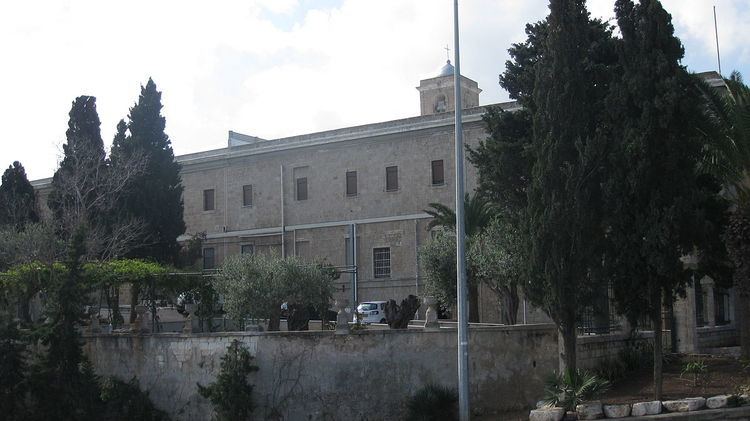Established 1631 Opened 1836 | Completion date 1836 Other information Facade faces South Phone +972 4-833-7758 | |
 | ||
Similar Cave of Elijah, Mount Carmel, Terraces, Stella Maris Light, Bahá'í World Centre | ||
The stella maris monastery or monastery of our lady of mount carmel in haifa july 23 2013
The Stella Maris Monastery (Hebrew: מנזר סטלה מאריס) or the Monastery of Our Lady of Mount Carmel for monks is a 19th-century Discalced Carmelite monastery located on the slopes of Mount Carmel in Haifa, Israel. Another Carmelite monastery of the same name (Monastère Notre-Dame-du-Mont-Carmel in French) is reserved for nuns and is located higher up on Mount Carmel.
Contents
- The stella maris monastery or monastery of our lady of mount carmel in haifa july 23 2013
- Carmelite monastery at stella maris haifa
- History
- Monastery
- Main church
- References
Carmelite monastery at stella maris haifa
History
In the 12th century, during the Crusader rule of the region, groups of religious hermits began to inhabit the caves of this area in imitation of Elijah the Prophet. In the early 13th century, their leader and prior (referred to in the rule only as 'Brother B,' although sometimes claimed despite an absence of supporting evidence to be either Saint Brocard or Saint Bertold) asked the patriarch of Jerusalem, Saint Albert, to provide the group with a written rule of life.
This was the originating act of the Order, who took the name 'Order of the Brothers of Our Lady of Mount Carmel' or Carmelites. The oratory was dedicated to the Virgin Mary in her aspect of Our Lady, Star of the Sea, (Latin: Stella Maris). Within a few decades, these monastic hermits left the troubled Holy Land and the Carmelite order spread throughout Europe.
At the end of Saint Louis’ first crusade to the Holy Land in 1254, he took six Carmelites back to France with him and the Order had begun to found houses throughout Europe from 1238 onwards. However, when Saint Jean d'Acre fell in 1291, they were forced to withdraw by Mamluks.
In 1631 the Discalced branch of the Order returned to the Holy Land, led by the Venerable Father Prosper. He had a small monastery constructed on the promontory at Mount Carmel, close to the lighthouse, and the friars lived there until 1761, when Zahir al-Umar, the then effectively independent ruler of Galilee, ordered them to vacate the site and demolish the monastery.
The Order then moved to the present location, which is directly above the grotto where the prophet Elijah is said to have lived. Here they built a large church and monastery, first clearing the site of the ruins of a medieval Greek church, known as "the Abbey of St. Margaret" and a chapel, thought to date back to the time of the Byzantine Empire.
This new church was seriously damaged in Napoleon’s 1799 campaign. Sick and wounded French soldiers were accommodated in the monastery, and when Napoleon withdrew, the Turks slaughtered them and drove out the friars.
In 1821, Abdullah Pasha of Acre ordered the ruined church to be totally destroyed, so that it could not serve as a fort for his enemies, while he attacked Jerusalem. The masonry was used to build a Abdullah Pasha's summer palace and a lighthouse, which were sold back to the Carmelite order in 1846.
The current church and monastery, built under the orders of Brother Cassini of the Order, was opened in 1836. Three years later Pope Gregory XVI bestowed the title of Minor Basilica on the sanctuary, and it is now known "Stella Maris", meaning Star of the Sea. For much of the 20th Century it was occupied by the Military, first the British, and later the Israeli, but at the end of their lease it was handed back to the Order.
Monastery
The Monastery serves as a centre of Carmelite spirituality throughout the world. The symbol of the Order is mounted right above the entrance door. During the erection of the church, friars were assaulted by their neighbors and had to defend their property and the church guests. As a result, the monastery's ground floor is built out of thick walls with few and small openings covered by bars.
Main church
The monastery's main church resembles the shape of a cross. Its dome is decorated by colorful paintings based on motifs from both the Old and New Testament: Elijah rising to heaven, David stringing his harp, the prophet Isaiah, the Holy Family and the four evangelists. Latin inscriptions of biblical verses are written around the dome.
The altar stands on an elevated platform situated above a small cave associated with Elijah. The cave can be reached from the nave by descending a few steps and holds a stone altar with a small statue of Prophet Elijah. The altar above the cave is dominated by a statue of the Virgin Mary carrying Jesus in her lap, known as "our mistress the Carmel".
New embossments dedicated to Carmelite figures are hoisted on all four corners of the central hall. On the western wall of the church is a large organ that is played during religious ceremonies and at special church music concerts.
